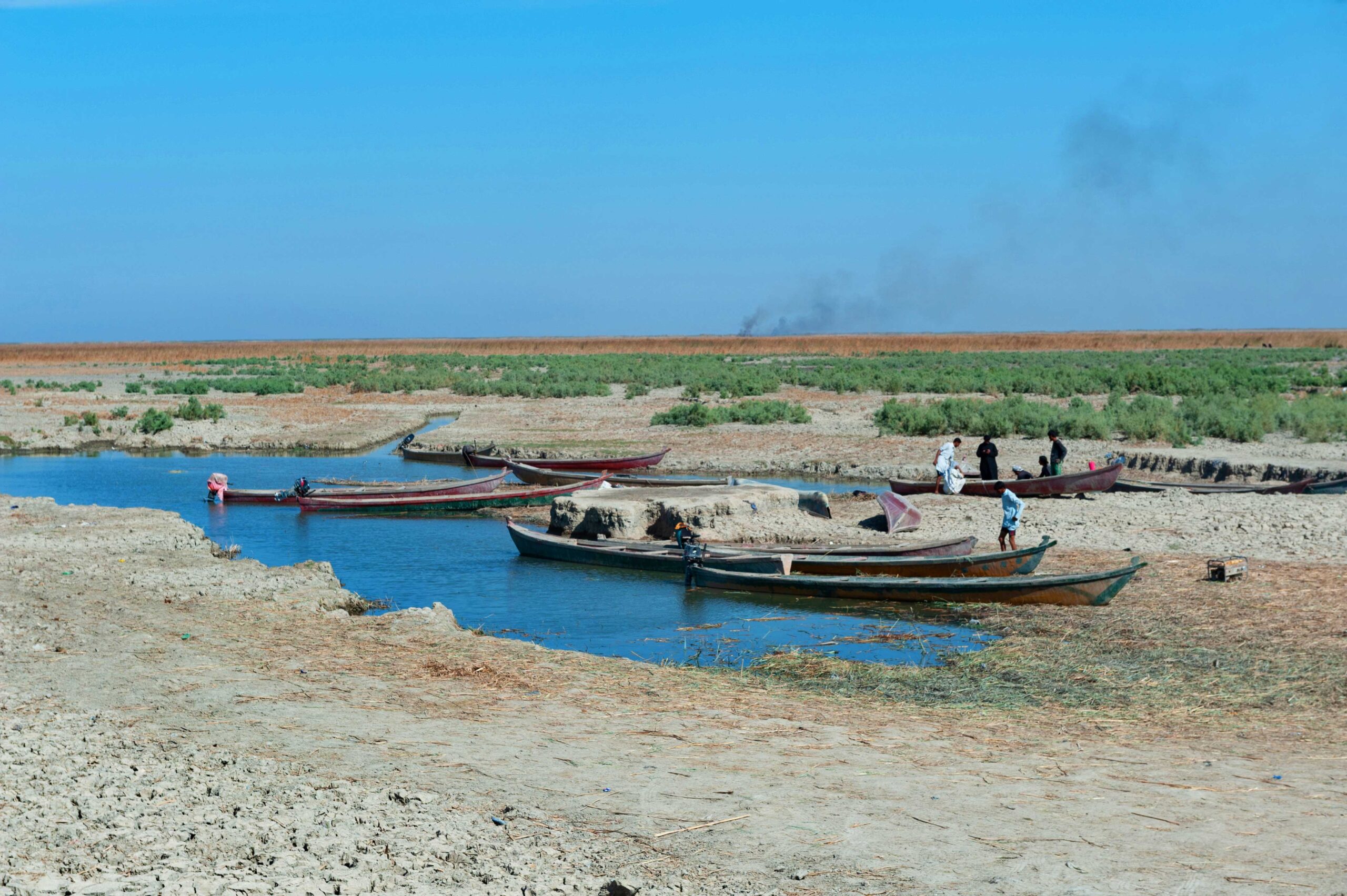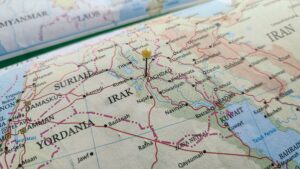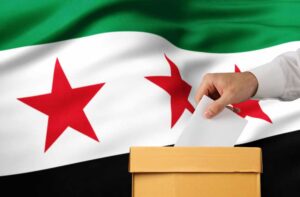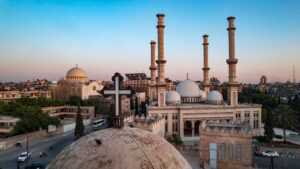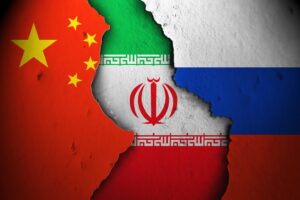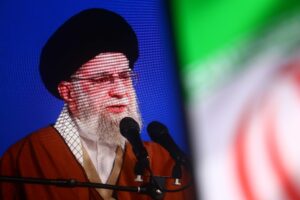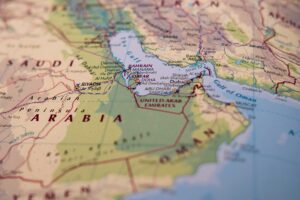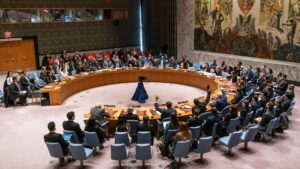Since the dawn of time the Iraqi people have lived in an arid land where winds carry scorching heat and water is scarce. The Iraqis invented sophisticated irrigation systems, taming the waters of the Tigris and Euphrates rivers to water their crops. They built houses of thick mud bricks that absorb heat during the day and release it at night, maintaining a stable temperature indoors. Wind towers called badgirs were fixed on roofs, catching the breeze to ventilate living spaces. And while Iraq survived the great droughts of the 13th and 16th centuries, like many other countries in the region, it was unprepared for sustained global warming.
The numbers behind the warming trend are staggering. Common heat peaks are at 50-51 degrees Celsius in the country. The Iraqi Ministry of the Environment recorded 270 dust storms, called yellow alerts, in just one year.[i] If nothing is done, the number could rise even further. The resulting phenomenon is polymorphic, and includes not only scorching temperatures, but also soil impoverishment, faulty irrigation, the extinction of flora and fauna, pollution, and the abandonment of farmlands to the wind (Shamal), increasing the dispersion of dust and the formation of asphyxiating dust clouds.
The fight against global warming requires a global response. Facing its effects acutely, Iraq finds itself in a critical situation. Its arable land surface has shrunk by 50 percent, according to the Iraqi Ministry of Agriculture.[ii] The governorates most affected are Maysan, Wasit, Dhi Qar and Diyala. The resulting exodus involves tens of thousands of families abandoning their farms, gardens and livestock. Villages are disappearing “for lack of resources,” says Abdul Zahra Al-Hindawi of the Iraqi Ministry of Planning. Once the people have left, conditions get worse. The wind kicks up dust from abandoned fields while clouds of dust invade the cities where the farmers have taken refuge. Baghdad does not hide the truth. Drought is officially considered to be one of the greatest threats to Iraq’s national security.[iii]
Chain Reaction
The first blow to Iraq’s environmental balance came in 1991, when President Saddam Hussein drained the marshes to punish a Shiite uprising. The wetlands (Chibayich, Hawizeh, al-Hammar), nicknamed the green lungs of Iraq, are a UNESCO World Heritage Site. Inhabited for five thousand years by Maadan hunters and fishermen, the region’s natural resources had been traditionally used sparingly and wisely. The construction of dams and diversion canals, the infamous “Saddam Canal,” diverted the waters of the Tigris and Euphrates to the Persian Gulf, forcing 500,000 residents to abandon the region. The blow to the environment was initially almost imperceptible, and only a few specialists sounded the alarm bells. From the 2000s onwards, alarmist messages gained urgency, and the link between degradation of the marshes and desertification became abundantly clear. The combination of “desertification + climate” shrunk the perimeter of the marshes, from 20,000 to 4,000 square kilometres (or 7700 to 1500 square miles).[iv] Species began to die out in the area, including the jackal, fox and hyena) as well as the native fish of ka’an and samti. Herds of buffalo began to fall victim to unknown diseases. The Iraqi authorities would have had to release 48 to 50 million cubic metres (or 12.6 to 13.2 billion gallons) of water into the marshes to restore them, but the country did not have that kind of volume at hand.
Inhabitants were forced to leave their traditional dwellings, mudhifs made of woven reeds. According to the Green Iraq Observatory, 130,000 people have left so far. Iraq’s agricultural sector has lost the corresponding manpower, and the lack of housing in urban areas has been exacerbated. Farmland has given way to urban expansion and is now housing only former farmers.
The Basra region is also affected. Described by the Arab thinker Al-Jahiz (776-868) as a “vast ocean” and nicknamed the Venice of the Arab world for its peaceful, fish-filled canals, Basra is now in dire straits. The Shatt al-Arab, flowing by, is polluted with toxins from sewage, industrial water, and the remnants of war: ammunition casings and discarded military equipment. The salt and chemicals in it create a toxic mix that makes the water unsafe to drink. In the summer of 2018, more than 100,000 inhabitants were infected with intestinal diseases linked to poor water quality. Along the banks, palm trees and vegetation are slumping. The region has lost 80 percent of its arable land. Basra is suffocating.
Forced to Adapt
Food prices are skyrocketing, especially for meat, due to the decline in livestock and the lack of fodder.
Although Iraq’s heavy industries (oil, gas, and manufacturing) have not yet been affected and overall macroeconomic numbers are holding up, certain sectors of employment, such as services and public administration, are strained. In response to extreme heat the government has adjusted working hours. In all governorates except Baghdad, the day begins at 7 AM and ends at 1 PM until late August. If the thermometer reaches 50 degrees Celsius (or 122 Fahrenheit), the governorates are free to take any emergency measures they deem necessary. However, as Major General Tahseen Al-Khafaji, spokesman for the Joint Operations Command, was keen to point out, the modified working hours do not apply to the armed forces or to health services, which stick to their regular schedules.[v]
The drought affects basic necessities. Residents of Baghdad receive messages from the Ministry of Health warning of diseases linked to the consumption of contaminated water: typhoid, hepatitis, cholera and other bacterial infections.[vi] Food prices are skyrocketing, especially for meat, due to the decline in livestock and the lack of fodder. Iraqis on modest incomes, who used to eat meat on Fridays and religious holidays, are cutting back. Today, despite high prices, a phenomenon of waste in consumption leads to about 120 kilograms of food per person per year being thrown out [vii] – with negative effects on the climate too. As Iraqi environmental expert Ahmed Abbas explained: “Food decomposes when it is thrown into landfills and produces methane, which is considered one of the greenhouse gases that contribute to climate change.”
There are unexpected inconveniences of the heat, some technical. The Civil Protection Directorate reported an increase in electrical transformers catching fire in air conditioners. Moreover, supporting high temperatures exacerbates tensions. Social scientist Wali Jalil Al-Khafaji observed a rise in climate-related domestic violence, as well as “increased murder and suicide rates in juvenile prisons during the summer.”[viii]
Political Response
Iraq will be the hottest country in the MENA region by 2050.
The Iraqi Ministry of the Environment is preparing for an upsurge in internal displacements, as thousands of families leave the marshlands. Humanitarian support operations are becoming more widespread. In the governorate of Diwaniyah, one of the hardest-hit by increasing temperatures, it is sometimes necessary to distribute emergency food aid. Increasingly, rising temperatures are becoming a matter of survival for the most destitute. According to the International Monetary Fund’s Climate Laboratory, Iraq will be the hottest country in the MENA region by 2050, with an average temperature of over 36 degrees Celsius (or 97 Fahrenheit).[ix] The current figure of 7 million out of 40 million Iraqis suffering from drought will likely increase too. The demographic curve appears such that the population will double in the next twenty-five years.
At the Cop26 climate change conference in Glasgow in 2021, the delegation from Baghdad presented a two-part plan to combat drought. The first covers the period from 2020 to 2025 and focuses on reducing carbon emissions. The second looks ahead to 2030 and aims to develop technology transfer, particularly in the irrigation sector. This is a key area. Iraqi agriculture uses old techniques that are no longer compatible with today’s climate challenges. Some farmers continue to use flood irrigation, which involves flooding farmland with large amounts of water. Not only is this water-intensive, it is also inefficient. Water evaporates in the sun or seeps deep into the soil, with little benefit to the plants in a context of severely compromised soil fertility. Irrigation using sprinklers, which saves 70 percent when compared to flooding, is met with resistance, as habits inherited from the past die hard. Yet, farmers can no longer rely on dams. Iraq’s dams currently hold back 20 billion cubic metres (5.2 trillion gallons) of water, while 50 billion cubic metres (13 trillion gallons) are needed to meet the country’s needs.[x] The situation may be tense, but it is not hopeless. The spring rains of 2024 have increased water reserves. The level of the Mosul Dam has risen by seven metres (23 feet). The situation has also improved in Dokan, Hamrin, Darbandikhan and Al-Azim.
Iraq has about twenty large dams but needs more of them to meet its needs. The Makhul Dam project, designed to hold 3 billion cubic metres (659 billion gallons), was to help irrigate the Salah al-Din and Kirkuk regions. Construction was interrupted by the American invasion in 2003. Work resumed in 2021 but was suspended because of its exorbitant cost.[xi] The Minister of Water Resources, Aoun Dhiyab Abdullah, prefers to build smaller dams, some of which are dedicated solely to power generation. They are cheaper and faster to build. Iraq plans to multiply the number of 30-million-cubic-metre (7.9-billion-gallon) storage centres throughout the country, as is already the case in Jumra (Erbil), Diwanah (Sulaymaniyah), Khans (Dohuk) and Torgar (Garmian).
Dam construction is accompanied by improved management of existing infrastructure, following years of political instability in which the sector was neglected. The Al-Azim Dam, for example, is better managed than it once was. Following a long dry spell, it is now full enough to irrigate farms and some urban areas. It is a small victory, but a victory, nonetheless. And that is what Iraq needs today, to multiply small victories throughout its territory.
Restoring Courage
Motivation is crucial in the face of global warming. This year, 30 to 40 percent of Iraqi farmers have abandoned their lands.[xii] There are two primary reasons for this: the lack of electricity and the rising price of gasoline, which is essential for running water pumps. A third reason is the harshness of working conditions and miserable revenues. The devaluation of the Iraqi dinar makes imports costly for farmers who want to invest in a new, economical irrigation system. Moreover, the government’s monopoly on agricultural inputs (subsidized seeds) is perceived by farmers as unfair, with chronic delays in government payments to farmers. On top of that, 5,544 fires were recorded between January and May 2024, destroying thousands of hectares of farmland and equipment.
The authorities in Baghdad have mobilized to support farmers who do not want to abandon their lands to the dust clouds. Aid programmes are being developed to promote innovative irrigation methods. The National Investment Commission (NIC) is working with the UN to fund emergency measures that will help keep rural people on their land and slow the desert’s advance.
Unexpectedly, the state is now setting an example by examining its own activities. The spokesman of the Ministry of Water Resources, Khaled Shamal, has boldly admitted that pollution is also caused by government agencies.[xiii] The health sector has been singled out for its failure to follow stringent rules of environmental management. Too many hospitals dump their waste into the Euphrates and Tigris rivers. The resulting pollution is appalling, as the waste includes vials of chemicals, human organ debris, and equipment that has been in contact with viral diseases. The same is true of industrial facilities such as petrochemical plants and power plants owned by the Iraqi state. In the future, each of these sites will build its own wastewater treatment plant.
International Cooperation
Iraq, with all the goodwill in the world, cannot do it on its own. Rivers have no use for human geopolitics. They flow across borders and international treaties. Upstream, Turkey controls about 70 percent of the waters of the Euphrates. Its plans to build some twenty new dams in Greater Anatolia are a cause for concern. Iraq’s Minister of Water Resources, Aoun Dhiab, makes no secret of his worries. Ankara “promised not to harm Iraq,” but, according to an Iraqi estimate, 35 percent of its water rights have not been honoured. This figure, which is difficult to verify, is indicative of latent tensions between the two countries. Iraqi diplomacy is mobilizing to redress what it sees as an unfair distribution of water resources. The Iraqi president demands strict compliance with signed bilateral agreements.[xiv]
The second bone of contention is with Iran. According to Iraqi calculations, 20 percent of the tributaries that Tehran is supposed to share are not flowing across the border. Iran disputes this claim. It points out that Iran’s contribution represents only 7 percent of Iraq’s consumption, and points to Baghdad’s water management failures, including exceeding abstraction quotas, the siltation of dams, and the existence of clandestine dams that retain water for private use.
Over the past four decades, MENA diplomats have signed a number of interstate agreements to try to harmonize water allocation, as detailed in the table below.

Source: Author
These agreements show a persistent imbalance between upstream countries (Turkey and Iran) and downstream countries (Iraq and Syria). The agreement signed with Ankara in 1989 sought to improve cross-border cooperation and tried to create a climate of trust. The same concern over a lack of trust is present twenty years later at the heart of another agreement, similar in every respect, but this time signed with Iran. Old and new disputes are at the heart of the concerns of the Tigris-Euphrates Basin Commission. A new agreement with Iran was signed in vain in 2019. In March 2024, an emergency meeting was held in Baghdad between the water ministers of Turkey and Iran to no effect. Tehran and Ankara refused to commit to allocation quotas, fearing for their own water security.
Yellow Alert
Iraq, on the climate frontlines today, has a culture of drought management. It took the combination of two phenomena since the 1980s – global warming + deregulation of water management – to create a situation that is bringing the Iraqi people to see the future in a different light.
If the fight against desertification is an emergency, it is a long-term emergency. Climate does not accept hasty political decisions. It only recognizes patience for generations to come. The Iraqi government has begun planting 5 million trees to reoxygenate its territory, mitigate the effects of pollution and slow the formation of dust clouds.[xv] The effects will be felt over several years, but this is exactly the kind of forward-looking decision the country needs.
A project to rehabilitate the marshes, the “green lungs” of the country, will transfer fresh water to preserve the remaining biodiversity. This will be complicated by the limited availability of water. Other bold measures should be taken, such as closing 2,500 illegal fish-farming ponds in the country. They may feed poor families, but their impact on resource management is disastrous. If Iraq wants to escape its predicament, it has no choice but to make difficult, even if unpopular, decisions.
This is not to suggest that the situation is lost. Far from it. Early results from the 2024 agricultural season are encouraging. The General Grain Trading Company has just announced a good wheat crop. The Minister of Agriculture, Muhammad Al-Khuzai, even hopes to achieve food self-sufficiency, an essential policy for Iraq.[xvi]
Iraq, like many Arab countries, has chosen to fight climate change. It would be a utopian notion to expect environmental issues to take precedence over political life, but they are a growing concern related to the welfare, and if not pursued consistently, even the survival of the population.
[i] Al-Araby (2022). “Dust storms paralyze Iraq. Baghdad Airport suspends flights for several hours”, 13 June 2022, retrieved from: https://www.alaraby.com/news/%D8%A7%D9%84%D8%B9%D9%88%D8%A7%D8%B5%D9%81-%D8%A7%D9%84%D8%AA%D8%B1%D8%A7%D8%A8%D9%8A%D8%A9-%D8%AA%D8%B4%D9%84-%D8%AD%D8%B1%D9%83%D8%A9-%D8%A7%D9%84%D8%B9%D8%B1%D8%A7%D9%82-%D9%85%D8%B7%D8%A7%D8%B1-%D8%A8%D8%BA%D8%AF%D8%A7%D8%AF-%D9%8A%D8%B9%D9%84%D9%82-%D8%B1%D8%AD%D9%84%D8%A7%D8%AA%D9%87-%D9%84%D8%B9%D8%AF%D8%A9-%D8%B3%D8%A7%D8%B9%D8%A7%D8%AA.
[ii] Emarat Al-Youm (2024). “Modern irrigation methods revitalize farmers’ land in drought-stricken Iraq”, 25 March 2024, retrieved from: https://www.emaratalyoum.com/politics/weekly-supplements/beyond-politics/2024-03-25-1.1838201.
[iii] Al-Ain (2023). “Iraq and the climate: agricultural crops suffer from lack of water and record temperatures”, 22 May 2023, retrieved from: https://al-ain.com/article/iraq-drought-crops-climate.
[iv] La Presse (2023). “Southern marshes dry up and a civilization dies in Iraq”, 15 July 2023, retrieved from: https://www.lapresse.ca/actualites/environnement/2023-07-15/les-marais-du-sud-s-assechent-et-une-civilisation-agonise-en-irak.php.
[v] Al-Forat News (2024).”A change without return”, 28 June 2024, retrieved from: https://alforatnews.iq/news/%D8%B5%D9%8A%D9%81-%D8%A7%D9%84%D8%B9%D8%B1%D8%A7%D9%82-%D8%B9%D9%88%D8%A7%D9%82%D8%A8-%D9%85%D8%AE%D9%81%D9%8A%D8%A9-%D9%88%D9%88%D8%AC%D9%87-%D8%A2%D8%AE%D8%B1-%D9%85%D9%86-%D8%AA%D8%AD%D8%AF%D9%8A%D8%A7%D8%AA-%D9%85%D8%B3%D8%AA%D9%82%D8%A8%D9%84%D9%8A%D8%A9.
[vi] The New Humanitarian (2016). “Iraq: Ministry of Health warns of water-borne diseases”, 6 June 2016, retrieved from: https://www.thenewhumanitarian.org/ar/report/183/%D8%A7%D9%84%D8%B9%D8%B1%D8%A7%D9%82-%D9%88%D8%B2%D8%A7%D8%B1%D8%A9-%D8%A7%D9%84%D8%B5%D8%AD%D8%A9-%D8%AA%D8%AD%D8%B0%D8%B1-%D9%85%D9%86-%D8%A7%D9%84%D8%A3%D9%85%D8%B1%D8%A7%D8%B6-%D8%A7%D9%84%D9%85%D9%86%D9%82%D9%88%D9%84%D8%A9-%D8%A8%D9%88%D8%A7%D8%B3%D8%B7%D8%A9-%D8%A7%D9%84%D9%85%D9%8A%D8%A7%D9%87.
[vii] Al-Forat News (2024). “Food waste and the economy in Iraq”, 28 January 2024, retrieved from: https://alforatnews.iq/news/%D9%87%D8%AF%D8%B1-%D8%A7%D9%84%D8%B7%D8%B9%D8%A7%D9%85-%D9%85%D8%AE%D8%A7%D8%B7%D8%B1-%D8%AA%D8%AA%D8%AC%D8%A7%D9%88%D8%B2-%D8%A7%D9%84%D8%A7%D9%82%D8%AA%D8%B5%D8%A7%D8%AF-%D9%88%D8%A7%D9%84%D8%A3%D9%85%D9%86-%D8%A7%D9%84%D8%BA%D8%B0%D8%A7%D8%A6%D9%8A-%D9%81%D9%8A-%D8%A7%D9%84%D8%B9%D8%B1%D8%A7%D9%82.
[viii] Ibid.
[ix] IMF.org, Climate Impact Lab, May 2023, retrieved from: https://www.imf.org/wp-content/uploads/2022/03/Climate-blog-chart2-temperatures53.jpg.
[x] Shafaq (2024).”Iraq. Water storage represents less than half of needs and a dark fate awaits the marshes”, 23 June 2024, retrieved from: https://shafaq.com/ar/%D8%AA%D9%82%D8%A7%D8%B1%D9%8A%D8%B1-%D9%88%D8%AA%D8%AD%D9%84%D9%8A%D9%84%D8%A7%D8%AA/%D8%A7%D9%84%D8%B9%D8%B1%D8%A7%D9%82-%D8%A7%D9%84%D8%AE%D8%B2%D9%8A%D9%86-%D8%A7%D9%84%D9%85%D8%A7-%D9%8A-%D9%82%D9%84-%D9%85%D9%86-%D9%86%D8%B5%D9%81-%D8%A7%D9%84%D8%A7%D8%AD%D8%AA%D9%8A%D8%A7%D8%AC-%D9%88%D9%85%D8%B5%D9%8A%D8%B1-%D9%82%D8%A7%D8%AA%D9%85-%D8%A8%D8%A7%D9%86%D8%AA%D8%B8%D8%A7%D8%B1-%D8%A7%D9%84-%D9%87%D9%88%D8%A7%D8%B1.
[xi] Al-Ahwar (2024). “Minister of Resources: Construction of 3 dams in the north of the country… and reveals the reason for stopping the Makhul dam”, 16 January 2024, retrieved from: https://alahwar-tv.com/news/%D9%88%D8%B2%D9%8A%D8%B1-%D8%A7%D9%84%D9%85%D9%88%D8%A7%D8%B1%D8%AF-%D8%A7%D9%86%D8%B4%D8%A7%D8%A1-3-%D8%B3%D8%AF%D9%88%D8%AF-%D9%81%D9%8A-%D8%B4%D9%85%D8%A7%D9%84-%D8%A7%D9%84%D8%A8%D9%84%D8%A7%D8%AF-%D9%88%D9%8A%D9%83%D8%B4%D9%81-%D8%B3%D8%A8%D8%A8-%D8%AA%D9%88%D9%82%D9%81-%D8%B3%D8%AF-%D9%85%D9%83%D8%AD%D9%88%D9%84.
[xii] Al-Araby (2022). “Displacement in southern Iraq due to water scarcity”, 20 August 2021, retrieved from: https://www.alaraby.co.uk/economy/%D9%86%D8%B2%D9%88%D8%AD-%D9%85%D9%86-%D8%AC%D9%86%D9%88%D8%A8-%D8%A7%D9%84%D8%B9%D8%B1%D8%A7%D9%82-%D9%84%D8%B4%D8%AD-%D8%A7%D9%84%D9%85%D9%8A%D8%A7%D9%87.
[xiii] Al-Forat News (2024). “Resources: Most government institutions pollute water, foreshadowing disaster”, 21 February 2024, retrieved from: https://alforatnews.iq/news/%D8%A7%D9%84%D9%85%D9%88%D8%A7%D8%B1%D8%AF-%D8%BA%D8%A7%D9%84%D8%A8%D9%8A%D8%A9-%D8%A7%D9%84%D9%85%D8%A4%D8%B3%D8%B3%D8%A7%D8%AA-%D8%A7%D9%84%D8%AD%D9%83%D9%88%D9%85%D9%8A%D8%A9-%D8%AA%D9%84%D9%88%D8%AB-%D8%A7%D9%84%D9%85%D9%8A%D8%A7%D9%87-%D9%85%D8%A7-%D9%8A%D9%86%D8%B0%D8%B1-%D8%A8%D8%A7%D9%84%D9%83%D8%A7%D8%B1%D8%AB%D8%A9.
[xiv] Iraqi News Agency (2024). “The President of the Republic stresses the need to reach an agreement with Turkey to solve the water problem”, 22 January 2024, retrieved from: https://www.ina.iq/201676–.html.
[xv] Al-Sumaria TV (2024). “The Minister of Agriculture told Alsumaria: “We have completed the planting of 3 million trees out of a total of 5 million”, 3 July 2024, retrieved from: https://www.alsumaria.tv/news/localnews/492831/%D9%88%D8%B2%D9%8A%D8%B1-%D8%A7%D9%84%D8%B2%D8%B1%D8%A7%D8%B9%D8%A9-%D9%84%D9%80-%D8%A7%D9%84%D8%B3%D9%88%D9%85%D8%B1%D9%8A%D8%A9-%D8%A3%D9%83%D9%85%D9%84%D9%86%D8%A7-%D8%B2%D8%B1%D8%A7%D8%B9%D8%A9-3-%D9%85%D9%84%D9%8A%D9%88%D9%86-%D8%B4%D8%AC%D8%B1%D8%A9-%D9%85%D9%86-%D8%A3%D8%B5%D9%84-5-%D9%85%D9%84%D8%A7%D9%8A%D9%8A%D9%86.
[xvi] Emarat Al-Youm (2024). “Modern irrigation methods revitalize farmers’ land in drought-stricken Iraq”, 25 March 2024, retrieved from: https://www.emaratalyoum.com/politics/weekly-supplements/beyond-politics/2024-03-25-1.1838201.

